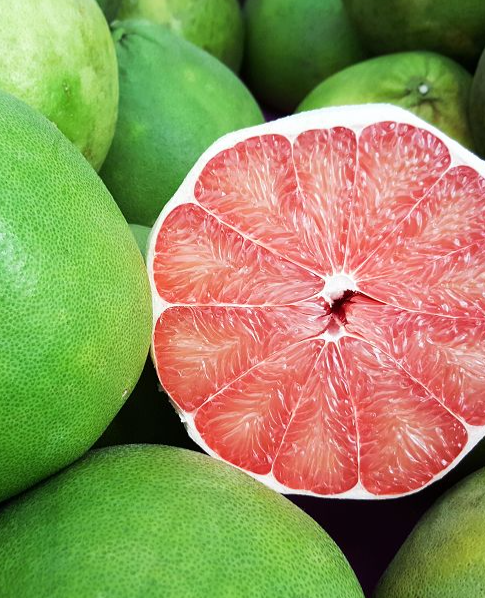News
The cultural significance of Vietnamese pomelo
Exploring the cultural, traditional medicine, and culinary roles of pomelo in Vietnam
In Vietnamese culture, the pomelo is a beloved fruit that almost every family grows in their garden. The large, round shape of the pomelo symbolizes abundance, prosperity, and good fortune. This makes it a popular choice for traditional celebrations. During festive seasons and holidays, Vietnamese people often place a pomelo on their ancestral altars as a gesture of respect and a wish for a prosperous year ahead.

How to eat pomelo
Peeling a pomelo is easier than it looks, and here’s how you can do it in a few simple steps:
Step 1: Start by cutting off the top and bottom ends of the pomelo.
Step 2: Make vertical cuts around the fruit, slicing about half an inch (1.5 cm) deep into the thick skin. Cut the skin into 4 to 6 sections evenly.
Step 3: Use your fingers to gently pull the sections of the skin away from the fruit. Don’t worry if the pomelo looks much smaller once it’s peeled — that’s totally normal!
Step 4: Next, use your fingers to split the peeled pomelo in half.
Step 5: Now, you can easily separate the individual segments.
Step 6: For each segment, peel off the outer membrane, and enjoy the juicy, refreshing goodness inside!
Traditional medicinal uses of pomelo in Vietnam
When it comes to flavor, the Nam Roi pomelo has a light, sweet taste with a subtle hint of tartness, yet without any of the bitterness you might find in some other citrus fruits. With a Brix level ranging from 9.67% to 10.82%.
Rind and Pith: In Vietnamese folk medicine, the rind and pith are boiled to create a soothing tea that’s great for cough relief. They also make a fantastic natural shampoo.
Blossoms: The fragrant flowers are brewed into a delightful tea that’s said to boost your mood and aid in digestion.
Leaves: Pomelo leaves are a go-to remedy for colds, providing a comforting and effective treatment.
Seeds: Pomelo seeds are traditionally used to help manage diabetes, showcasing the fruit’s wide range of medicinal uses.
Food made from pomelo
Next up, we’re diving into some classic Vietnamese dishes that make the most of every part of the pomelo fruit. From rind to flesh, discover how this versatile fruit is used in traditional recipes!
This heavenly made pomelo has great purposes such as weight loss, easy digestion and beauty enhancement. Besides, it is also used for processing snacks that gain Vetnamese people’s love throughout the years: drinks such as smoothies, juices, jam or sauce for savory dishes.
Vietnamese pomelo sweet soup (chè bưởi)
The most famous among the dishes made from pomelo must be the signature Vietnamese dessert – Che Buoi. With just one teaspoon of this dish, visitors will taste the sweet and creamy, rich flavor of childhood, promising to bring your memory back to the golden padding fields, mid summer air of the nostalgic Vietnamese village.

Vietnamese pomelo sweet soup is a traditional Vietnamese dessert made by combining pomelo pith, mung beans, sugar, coconut, and tapioca starch. The ingredients are mixed and cooked to create a thick, pudding-like consistency. The result is a deliciously fragrant treat that’s perfect for hot summer days. The chewy pomelo pith adds a unique texture, while the mung beans and coconut bring a sweet, refreshing flavor.
Candied pomelo peel and pith (mứt bưởi)
To make candied pomelo peel and pith, the pomelo rind and pith are cut into thin strips and thoroughly washed to remove any bitterness. After some simple steps to prepare the peel, it is then soaked in sugar for about 4 hours. Once the peel is fully coated with sugar, the mixture is placed in a pan and cooked over low heat, stirring constantly until the sugar crystallizes and the peels dry out. The result is a delicious treat with a light, sweet flavor and a crisp, citrusy aroma. Vietnamese people often enjoy this snack with a cup of green tea.



 Vn
Vn 中文
中文